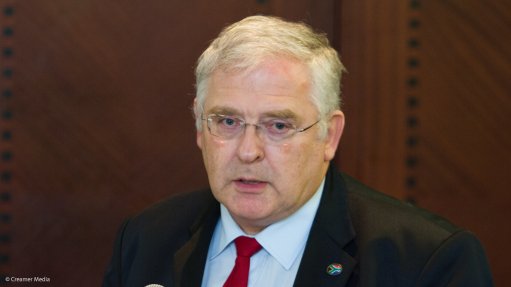
Eskom chief nuclear officer Dave Nicholls
Photo by: Duane Daws
A Request for Proposals (RFP) for new nuclear power plants (NPPs) and a new research reactor could be issued by the middle of this year. This was reported by Eskom chief nuclear officer Dave Nicholls at the Nuclear Africa 2017 conference on Wednesday. In parallel, the process of obtaining the necessary regulatory approvals will continue. Most of these should be secured by early next year.
"It will probably be issued as a joint Eskom/Necsa RFP," he said. Eskom is the country's national electricity utility and the owner and operator of South Africa's only NPP, at Koeberg near Cape Town. Necsa is the South African Nuclear Energy Corporation, which owns and operates the SAFARI-1 research reactor at its complex at Pelindaba, west of Pretoria.
Should it be issued, the RFP will probably be divided into Eskom and Necsa sections, because of their very different requirements, but the two State-owned entities would coordinate in order to ensure that their decisions were complimentary. The RFP would not be a closed bid.
Should the RFP be released by the middle of this year, Nicholls hopes that it could lead to contracts being signed in late 2018 or early 2019. He stressed that this was not a target date; indeed, there was no target date.
"There is an Eskom procurement process, a National Treasury procurement process and an IAEA [International Atomic Energy Agency] procurement process," he noted. But, in practice, "[t]hey are exactly the same!"
"You can build nuclear fast, if you want to," he affirmed, citing France and China as examples. Koeberg was built between 1976 and 1984 and would have been completed two years sooner if it had not been for sabotage during the construction phase.
Nicholls listed Eskom's "key approaches" to the construction of new NPPs. The programme had to be structured on a national basis. The construction of the early units would have to be led by the vendor companies, there would be a "fleet build" programme (that is, all the NPPs would be to the same design), the sites for the new NPPs would be driven by the needs of the power transmission grid, there would be a reference unit for the NPP design chosen and there would be an established design basis for it.
"We are fanatical about a reference unit," he affirmed. Vendors must not bid on the basis of specifications only; they had to bid on the basis of a real NPP that is under construction elsewhere, detailing any design changes for South Africa and keeping any such changes to the absolute minimum. The established design basis was particularly important for the latest designs of NPP, where the first unit may not yet have been completed.
Eskom will also build on the experiences it has gained with Koeberg; from its negotiations with international vendors for the Nuclear One project in 2007/2008 (for which the contracts were ready for signature when that NPP programme was stopped); "the lessons learned from the Medupi, Kusile and Ingula projects"; international experiences with both domestic and imported nuclear programmes; the "need to achieve the lowest credible cost"; and local content in the programme.
"Koeberg had a 93.38% availability last year," highlighted Nicholls. "Can we run a nuclear power station? I believe we can."